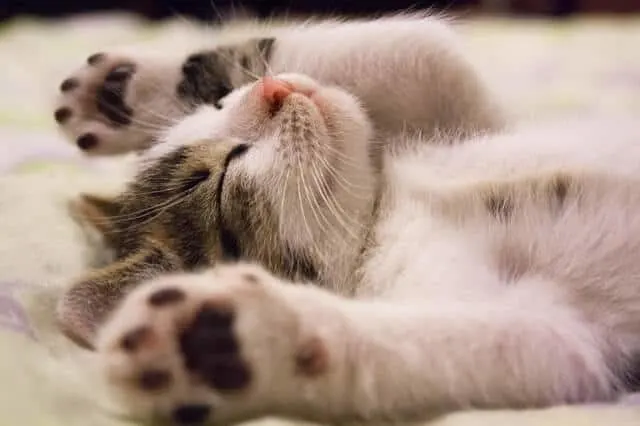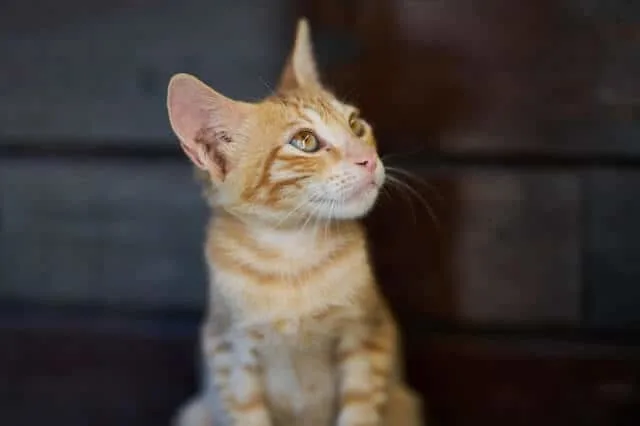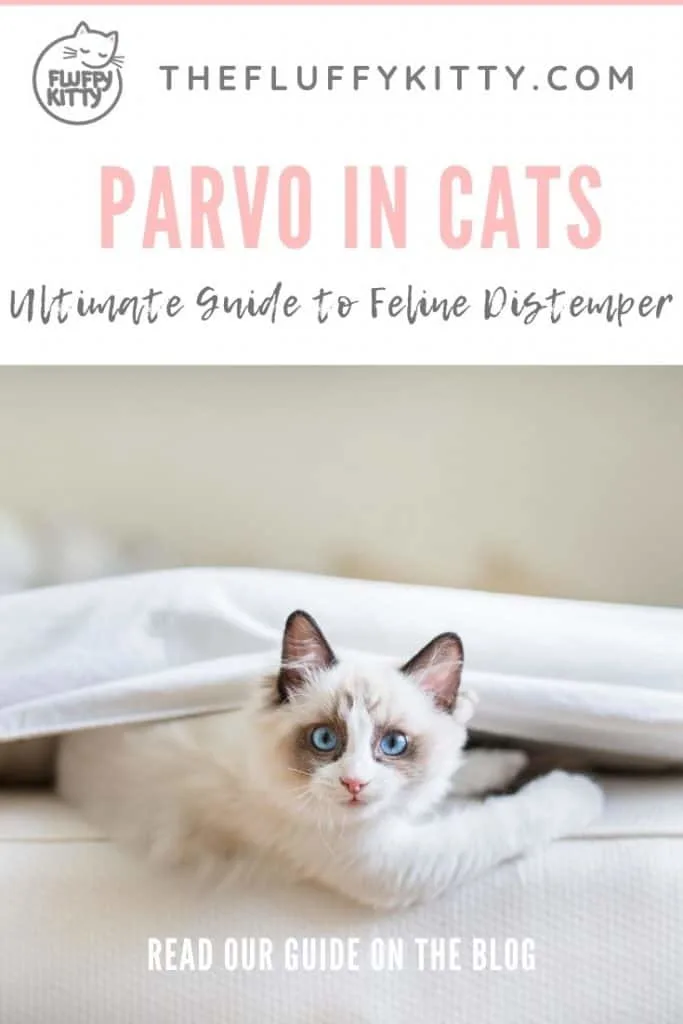Taking care of your cat’s health might prove to be more difficult than you think! There are just as many potential threats to your cat’s health as there are to your health, as a human being. Parvo in cats and Feline distemper is only one of the many diseases affecting cats.
Read more below to find out all about feline distemper in cats! From what causes parvo, its symptoms, to possible ways to diagnose and treat it. More importantly, find out how to prevent your cat from getting affected by the Parvovirus in the first place.
In this article:
- What is Parvo and Feline distemper in Cats??
- How do Cats Get Feline distemper?
- Symptoms of Feline distemper in Cats
- Diagnosis of Feline distemper in Cats
- Treatment for Feline distemper in Cats
- Prevention of Parvo and Feline distemper in Cats
- Can I Get Parvo from My Cat?
- Final Thoughts
- References
What Is Parvo and Feline distemper in Cats?
Parvovirus is a common virus that affects cats causing a highly deadly disease known by the term of Feline distemper or Feline panleukopenia.
We are talking about a highly dangerous and life-threatening disease in cats. Parvo in cats is highly contagious and usually targets and affects young, unvaccinated cats. The most important fact to remember about Feline distemper is that it is effectively preventable via timely vaccination.

While cats of all ages are at risk, it is unvaccinated kittens, especially ones with weak immune systems, who are likely to contract the Parvovirus. In fact, in the circles of unvaccinated cats, Parvovirus, and with that the Feline distemper, is what is guilty of a high mortality rate.
How do Cats get Feline distemper?
As we mentioned earlier, Feline distemper is caused by the Parvovirus. Parvo in cats is easily transmissible from an infected cat to a susceptible cat, most commonly through the feces and urine.
Parvo in cats is passed into the urine and feces of the infected cat during the infection itself, but also in the six weeks after the cat’s recovery as well.
The Parvovirus can also be transmitted by getting into contact with items that the infected cat has used during the infection and the treatment itself including any food bowls, sandboxes, clothing, toys, etc. The Parvovirus is highly transmissible from an infected mother to her kittens during her pregnancy.
As soon as the susceptible cat is in contact with the urine or feces of the infected cat, the Parvovirus is transmitted.
The virus will begin affecting the growing cells of the cat. Then, the virus attacks the gastro-digestive system, bone marrow, lymph tissue and the nervous system, which later causes the characteristic symptoms of distemper in cats to develop.
Symptoms of Feline distemper in Cats
Although it happens more rarely, adult cats do get affected by the Parvovirus and develop the symptoms of Feline distemper as well. However, adult cats very rarely show any symptoms. As for young, unvaccinated kittens, they usually die within 12 hours after they have been affected.
Parvovirus most commonly affects the fast-growing cells of the gastrointestinal system, bone marrow, nervous system, and the lymph tissue, so symptoms from these body systems are highly likely.
The most common symptoms are fever, signs of depression, diarrhea, vomiting, loss of appetite and severe dehydration. [1]
If the Parvovirus infects a pregnant cat and it develops the symptoms of Feline distemper, the virus can cause abortion or stillbirth to happen. This is especially so if the infection has spread in later pregnancy.

In the case the disease occurs in early pregnancy, it may cause fetal resorption (death of the embryos) and infertility. This is the case even after the infection has been successfully treated. If the Parvovirus affects kittens before their birth, they can develop severe brain abnormalities such as seizures, poor coordination, and poor motor skills.
How to Diagnose Feline distemper in Cats?
Your vet can diagnose Feline distemper with the help of your cat’s medical history, physical exam, present symptoms, and laboratory tests.
Feline distemper can be easily mistaken for other common medical conditions such as Feline Leukemia and Feline immunodeficiency virus. Therefore, it is essential for all of the tests and exams to be performed carefully to avoid any mistakes that can endanger the life of the cat.
With the physical exam, the veterinarian will discover fever and signs of severe dehydration. And through palpations on the abdomen, the vet will find thickened intestines and enlarged lymph nodes.
Laboratory tests will show extremely low white blood cells count and a reduced number of blood platelets as well. A urine analysis will detect the presence of the Parvovirus and help confirm the diagnosis. A feces analysis of the infected cat also helps to diagnosis feline distemper in cats.
How to Treat Feline distemper in Cats?
Because there is no specific antiviral therapy for Parvo in cats and Feline distemper in cats, it is all about supportive treatment.
The infected cat is isolated away from any other cats and animals, as to reduce the risk of other cats getting affected by the Parvovirus and develop the symptoms of the Feline distemper.
Through fluid therapy, the symptoms of dehydration are treatable. Otherwise, no food and water until the symptoms of diarrhea and vomiting disappear. For that purpose, the vet will administer a careful variety of medications and antibiotics. The antibiotics will help combat any secondary bacterial or viral infection that may develop.
After the symptoms of diarrhea and vomiting disappear (after about 12 hours), your cat can have small amounts of water and bland food. If the cat is severely anemic due to the virus, blood transfusions are possible. [2]

Successful treatment of the symptoms of Feline distemper in cats takes around one week. Adult cats have better chances of surviving the Parvovirus in comparison to young kittens.
If a cat survives the symptoms of Feline distemper, no side-effects later in life are likely. You can expect your cat to live a long and happy life. 🙂
Prevention of Parvo and Feline distemper in Cats
The best way to prevent your cat from contracting Feline distemper is to vaccinate your cat during her days as a young, cheerful kitten.
All kittens need the vaccination against this highly contagious disease by getting their Feline distemper vaccine. The Feline distemper shot for cats is safe and rarely causes any side-effects to develop.
If your cat has suffered from Feline distemper, it is extremely wise that you disinfect every surface which your cat has had contact with. This means washing every surface and item that your cat has every used, especially its litter box, food bowls, toys, etc. Bleach is the best option for dezincification when it comes to the Parvovirus in cats. [3]
Can I get Parvo from my Cat?
Good news is that the Parvovirus is only transmitted between animals of the same species. So you are not at any risk from getting the Parvovirus from your cat or dog.
However, it is good to know that the Parvovirus affects humans as well. It is transmissible from a human to another human. The Parvovirus in humans can show no symptoms. But oftentimes, it can cause a red skin rash and fever to occur and last for around one week.
So do not worry! Although your cat can get the Parvovirus, you are not at risk. You are, however, exposed to the Parvovirus when you are around its human carriers. If you know of a human carrier, be cautious and report any symptoms to your doctor. [4]
Final Thoughts: Parvo in Cats
Now you know what Parvo in cats is, congrats! Here are a few takeaways from this article:
- Cats get feline distemper via the parvovirus.
- Yes, parvo in cats is transmissible to other unvaccinated cats.
- Symptoms range from fever, severe dehydration, diarrhea and vomiting.
- How to diagnose and treat parvo in cats is rather simple with lab tests and antibiotics, but you must act quickly.
- Although the Parvovirus is a dangerous one, it is easily preventable with a quick vaccine.
- Do not hesitate to get your cat’s vaccinations right away!
Thanks for reading Fluffy Kitty! Share this article to spread the “mews” with all kitty-lovers!
More about the author of this article:
Dr. Ahmed Zayed holds a baccalaureate of Medicine and Surgery. He has completed his degree at the University of Alexandria, Egypt. Dr. Ahmed believes in providing knowledgeable information to readers. Other than his passion for writing, Dr. Ahmed spends his time outside the hospital, either reading or at the gym.
References
[1] https://www.petmd.com/cat/conditions/infectious-parasitic/c_ct_feline_panleukopenia [2] https://www.petcoach.co/article/panleukopenia-feline-distemper-in-cats-kittens/ [3] https://www.petwave.com/Cats/Health/Panleukopenia.aspx [4] https://www.petmd.com/dog/wellness/evr_dg_parvovirus_across_species

Reeda A Miller
Saturday 5th of September 2020
I had no idea parvo existed in cars. We lost a dog to parvo a. Few months ago. We recently had 3 litters of kittens ranging from 4-6 weeks of age. In 3 says we lost 5 out of 12 kittens and the others aren't out of the woods. I wish I had read this earlier
The Fluffy Kitty
Wednesday 23rd of September 2020
Oh I'm so sorry! Did they ultimately pass from contracting parvo, then?